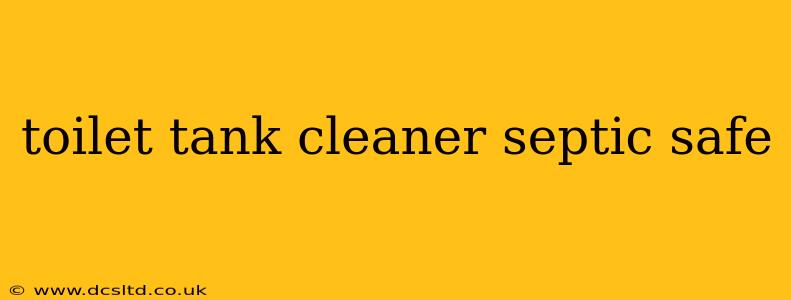Maintaining a clean and functional toilet is crucial for every household. However, using harsh chemical cleaners can damage your septic system, leading to costly repairs. This comprehensive guide explores the best septic-safe toilet tank cleaners, addressing common concerns and providing expert advice to keep your plumbing healthy and your toilet sparkling. We'll cover everything from the ingredients to look for and avoid, to the proper application methods, and even DIY solutions.
What Makes a Toilet Tank Cleaner Septic Safe?
The key difference between a regular toilet bowl cleaner and a septic-safe one lies in its ingredients. Many commercial cleaners contain harsh chemicals like bleach, chlorine, and phosphates, which can disrupt the delicate bacterial balance in your septic system. Septic-safe cleaners are formulated with gentler, biodegradable ingredients that won't harm the beneficial bacteria responsible for breaking down waste. Look for products explicitly labeled "septic safe" or those that clearly list their ingredients, allowing you to verify their suitability.
Are All "Natural" Toilet Cleaners Septic Safe?
While many natural cleaners are gentler on septic systems than harsh chemical cleaners, it's crucial to check the label. Even some natural cleaners might contain ingredients that could negatively impact your septic tank's bacteria. Always verify that the product is explicitly labeled as septic-safe to avoid any potential problems. The term "natural" doesn't automatically guarantee septic safety.
What Ingredients Should I Look For (and Avoid) in a Septic-Safe Toilet Tank Cleaner?
Ingredients to Look For:
- Biodegradable surfactants: These are cleaning agents that break down naturally and won't harm your septic system.
- Enzymes: These help break down organic waste, assisting the natural processes within your septic tank.
- Citric acid: A natural acid that's effective at cleaning and is generally septic-safe.
- Baking soda: A mild abrasive that helps scrub away stains.
Ingredients to Avoid:
- Bleach: Highly corrosive and disruptive to septic tank bacteria.
- Chlorine: Similar to bleach, it's harmful to beneficial bacteria.
- Phosphates: Contribute to excessive algae growth and can upset the septic system's balance.
- Formaldehyde: A known toxin that should be avoided.
How Often Should I Clean My Toilet Tank with a Septic-Safe Cleaner?
The frequency depends on several factors, including the number of users and the water hardness in your area. As a general guideline, cleaning your toilet tank every 2-3 months with a septic-safe cleaner is usually sufficient for most households. However, if you notice mineral buildup or staining, more frequent cleaning may be necessary.
Can I Make My Own Septic-Safe Toilet Tank Cleaner?
Yes! A simple and effective DIY solution involves combining white vinegar and baking soda. The combination's effervescence helps to clean the tank, while the vinegar acts as a natural disinfectant. Simply pour one cup of white vinegar into the toilet tank, followed by one cup of baking soda. Let it sit for several hours or overnight before flushing. This method is inexpensive and environmentally friendly.
What if I Accidentally Used a Non-Septic Safe Cleaner?
If you accidentally used a non-septic-safe cleaner, don't panic. Flush your toilet several times to dilute the cleaner. Monitor your septic system for any unusual activity, such as slow drains or unpleasant odors. If you notice any issues, contact a septic tank professional for advice.
How Do I Choose the Right Septic Safe Toilet Tank Cleaner for My Needs?
Choosing the right cleaner involves considering several factors. Read the product label carefully, paying close attention to the ingredients. Look for products explicitly labeled as septic safe, and consider factors such as scent and concentration. Some prefer unscented options, while others prefer cleaners with a light fragrance. The concentration of the cleaning agents will determine how much you need to use per application.
By following these guidelines and choosing the right septic-safe toilet tank cleaner, you can keep your toilet clean and your septic system functioning optimally for years to come. Remember, prevention is key to avoiding costly septic system repairs.
